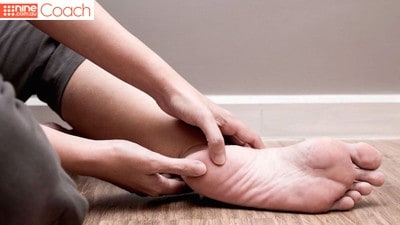
Blog, Sports Care

Your guide to choosing the best netball shoe
“The days of calling netball a non-contact sport are well and truly over,” says sports podiatrist and founder of A Step Ahead Foot + Ankle Care Dr Brenden Brown.
He says netball is not only physically demanding, it’s a high-impact sport in which foot and ankle injuries are rife (particularly if players aren’t wearing appropriate footwear!).
Do players really need new netball shoes every season?
Short answer is, ‘Yes, they do!’
“Netball involves lots of twisting on one foot, side to side motion, jumping and running—as a consequence, many players get ankle sprains. Having a new pair of shoes at the beginning of netball season is essential. It’s an injury-prevention no-brainer!
“Good quality netball shoes go a long way to assisting with injury prevention. I witness this time and time again…I’m a netball Dad and when I see a child on the sideline with an injury, it’s universally in a poor shoe,” says Dr Brenden.
Regular runners vs netball shoes: what’s the difference?
Mark Doherty, ASICS general manager of product, knows a thing or two when it comes to sports shoes. He explains that the sole of a netball shoe is a lot different to that of a running shoe.
“We tend to use solid rubber in the soles of our netball shoes, whereas in a running shoe we use blown rubber which is an air injected rubber.
“While we want netball shoes to be lighter and lighter, we also need to make sure they last and offer the wearer the protection they require.
“Solid rubber has the ability to wrap around the shoe and it also stabilises the shoe so that when you go into cross-lateral movements there’s the solid platform you need.
“If you were wearing a running shoe, the shoe could potentially collapse on the lateral sides because of the movement involved in netball.”

What makes a great netball shoe?
“When choosing a netball shoe consider cushioning, stability, support and weight (you want it to be lightweight). A firm heel counter is important and there should be minimal twisting or ringing out of the shoe,” says Dr Brenden.
“An adequate toe box is essential too. Make sure the shoe is comfortable and roomy enough around the toes when you first try it on; these shoes are NOT designed to stretch.”
Mark says the basic principle is that a netball shoe should have a more stable base than a running shoe, but it’s also important to consider durability and performance of the shoe to last longer.

Are new designs just marketing hype?
“We have a couple of top shoe models that we change every two to three years, based on the latest technology. This might allow us to make the shoe lighter, more durable or more flexible,” says Mark.
“For 2018 ASICS’s introduced the new Netburner Professional with an updated midsole foam that’s much lighter than any foam we’ve ever developed before.
“The Professional has more of a running-type feel to the shoe with the added bonus of that extra protection that’s needed in a netball shoe.”

Final note: It pays to get professional advice when choosing a netball shoe.
“When you’re buying a sports-specific shoe, it’s a great idea to get professional advice.
“If you’re someone with a really high arch and you select a shoe that’s designed for someone with a low arch you are VERY likely to increase your risk of injury,” says Dr Brenden.
“Shoes differ from season to season—for example the Netburner Professional has a new, more flexible, upper material this year—which can change the feel of the shoe.
“But also, a shoe is like a fingerprint; because of the amount of manual labour involved, no two shoes are the same,” says Mark.
“Even if you pull out two size eights in the same shoe, there can be slight differences because of the tolerances you have in midsole density or the upper might be slightly different. It’s always best to try on shoes to allow for these minor differences.”
A Step Ahead Foot + Ankle Care is one of Sydney’s leading foot and ankle clinics. Principal podiatrist and founder of A Step Ahead Dr Brenden Brown (AKA Dr Foot) has been taking care of people’s feet for more than 20 years.
With a background in sports medicine and having served as a former president of the Australasian Podiatry Council, Brenden is a wealth of information when it comes to foot and ankle care.
Got a foot-related question? AskDrFoot

Blog, Heel Pain

In the media: Dr Brenden Brown talking heel pain on Channel Nine’s Coach website
It’s true there’s nothing sexy about foot pain, but nonetheless it’s a common complaint that shouldn’t be overlooked.
Dr Brenden Brown, sports podiatrist and founder of A Step Ahead Foot + Ankle Care, recently chatted to the folks over at Coach to explain the popular causes of heel pain and what can be done about it.
“Most heel pain is some form of change to the large tendon that travels in the bottom of the foot and up the back of the heel — tendons hate change,” Dr Brenden tells the team at Coach.
“The moment you massively change your activity over a short period of time, [the tendons] get really sore and angry,” Dr Brenden explains.
To read the article in full, head on over to Coach.
ABOUT DR BRENDEN BROWN
A Step Ahead Foot + Ankle Care is one of Sydney’s leading foot and ankle clinics. Principal podiatrist and founder of A Step Ahead Dr Brenden Brown (AKA Dr Foot) has been taking care of people’s feet for more than 20 years.
With a background in sports medicine and having served as a former president of the Australasian Podiatry Council, Dr Brenden Brown is a wealth of information when it comes to foot and ankle care.
He has appeared on Sunrise, The Today Show, Mornings with Kerri Anne and Current Affair. Dr Brenden Brown is a regular on Wendy Harmer’s Sydney’s Morning on ABC Radio and has also shared his expert know-how in the field of feet in Men’s Health, Cosmopolitan magazine, The Sydney Morning Herald, New Idea, The Australian and The Daily Telegraph.
Dr Brenden Brown is passionate about sharing his stellar knowledge of common and complex foot issues and raising awareness of the importance of foot health.

Blog

Your guide to rock-solid ankle stability
Your feet and ankles are the foundation of your body so imagine the persistent feeling that your ankle is going to “give away” or actually having your ankle collapse under the weight of your body? Ouch!
Sports podiatrist and founder of A Step Ahead Foot + Ankle Care Dr Brenden Brown explains, “Ankle instability is that uneasy feeling that your ankle is going to roll out, particularly when walking or running on rough surfaces.
“We tend to think of these ‘rough’ surfaces as being a rocky terrain or very unsteady ground but for someone who has had a previous ankle sprain, a rough surface can simply be a bump in a soccer field.”

So what are some key points about ankle instability?
- Having an ankle sprain increases the chance of another ankle sprain
- Those people who have an ankle sprain but don’t undergo physical therapy and rehabilitation are significantly more likely to re-sprain
- Repeated spraining or injury to the ankle can lead to chronic ankle instability (this can seriously effect quality of life)
- In fact, 33% of people with first time ankle sprains go on to develop chronic ankle instability.
- You can’t cure ankle instability by doing nothing. Evidence suggests it’s very unlikely it will get better by itself.
- Stopping exercise or playing sports won’t alleviate ankle instability but could cause other negative health impacts.
While many people underestimate the impact of ankle instability and simply don’t pay their ankles the attention they deserve, other causes include hyper-mobility (being double jointed), a very high foot arch and weak muscular control in a single leg.
Treating ankle instability
“When it comes to treatment, it’s important to note that it’s not just about the ankle – you need to consider the whole limb,” says Dr Brenden.
“Unfortunately, there’s also the common misconception amongst many health professionals that a single style of treatment will make ALL ankle sprains better. This isn’t so; treatment should be tailored to the type of sprain.
“Similarly, there’s the misunderstanding that wearing an ankle brace or taping the ankle will prevent ankle instability. Not so.
“We’re finding that the entire leg, in particular the glutes and all the muscles above the ankle are more vital than we ever thought before.
“If you have weak glutes or poor hip function on your left hand side you’re significantly more likely to twist your left ankle.”
Aside from just focusing on the ankle itself, Dr Brenden says there’s a growing body of evidence to support strength work through exercise.
This involves firstly identifying where the muscle imbalance is coming from and then performing targeted strength exercises.
“I have a real problem with healthcare practitioners who only ever tell people with ankle instability to do calf raises. If you’re a tennis player, calf raises are inappropriate because you’re jumping side to side rather than raising the feet up and down.
“Rehabilitation exercises need to be specific to the sport you play. You can’t take a ‘one-size-fits-all’ approach.”
Other methods of treatment include:
Footwear— A firm base and firm heel counter (we’re talking good quality trainers) is important while the ankle is unstable.
Orthotics—There’s a sound body of evidence that suggests looking at foot posture can be helpful. Over use of the muscles can affect the way the foot moves and, if left untreated, this can lead to ankle instability.
“The vast problem is that people delay treatment and end up having multiple ankle sprains, which not only damages the anterior talofibular ligament (ATFL) but the surrounding muscles as well.”
Ultimately, poor ankle stability can lead to a chain reaction of injury so it’s important to talk to your local podiatrist to find out the best method of action.
A Step Ahead Foot + Ankle Care is one of Sydney’s leading foot and ankle clinics. Principal podiatrist and founder of A Step Ahead Dr Brenden Brown (AKA Dr Foot) has been taking care of people’s feet for more than 20 years. With a background in sports medicine and having served as a former president of the Australasian Podiatry Council, Brenden is a wealth of information when it comes to foot and ankle care.
Find out more about ankle sprains and how to treat them
Got a question? Check out our Instagram profile #AskDrFoot
Or simply tune into our Facebook page for regular live videos and updates on the latest foot and ankle advice from the experts.














 Dr Brenden’s White paper report on the “6 Reasons You Won’t Beat Heal Pain” outlines what’s stopping you from beating this and tips on how to stop it in its tracks!
Dr Brenden’s White paper report on the “6 Reasons You Won’t Beat Heal Pain” outlines what’s stopping you from beating this and tips on how to stop it in its tracks!